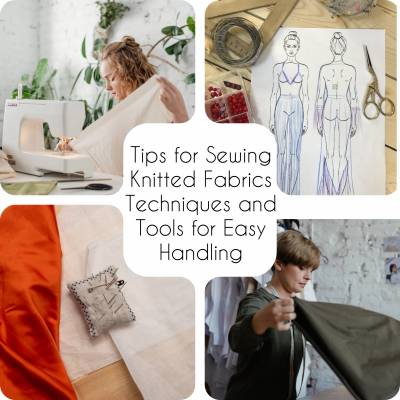Tips for Sewing Knitted Fabrics-Techniques and Tools for Easy Handling
Tips and tricks.
Tips for Sewing Knitted Fabrics-Techniques and Tools for Easy Handling
Working with knitted fabrics can be challenging, especially if you are more familiar with woven materials. However, with some easy hacks and the right tools, you can transform your experience and master the art of sewing knits. In this guide, we'll explore different types of knitted fabrics, essential sewing tips, and the differences between a serger/overlocker and a regular sewing machine. Whether you're a seasoned seamstress or a beginner, these techniques will help you achieve professional results while working with stretchy fabrics.

Types and Classification of Knitted Fabric:
Knitted fabric is known for its stretchiness, thanks to the manufacturing process involving large knitting machines and fine threads, sometimes even elastic thread. It can be classified based on the amount and direction of stretch:
Types:

- One-way stretch
- Two-way stretch
- Four-way stretch
Sewing Tips for Knitted Fabrics:
Follow these essential tips to ensure smooth and successful sewing with knits:
- Choose the Right Needle: Opt for a jersey or ballpoint needle, as regular needles can cause skipped stitches. The rounded tip of these needles slips between the knit fibers, preventing pulls and tears. Consider using a stretch needle for fabrics with spandex (lycra).
- Use Zigzag Stitch or Overlocker: Employ a zigzag stitch or an overlocker instead of a straight stitch to allow the fabric to stretch without breaking the stitches.
- Experiment with Stitch Lengths: Try different stitch lengths to find the best one for your fabric. A shorter stitch length helps maintain the fabric's shape and prevents stretching.
- Utilize Sewing Machine's Feed Dogs: Let the machine feed the fabric without pulling or pushing it, as this can lead to distortion.
- Keep Fabric Flat: Prevent bunching or stretching by keeping the fabric flat and smooth. Use pins or sewing pegs to hold it in place.
- Use Polyester Thread: Opt for polyester thread, which offers some stretch and durability, making it ideal for sewing knitted fabrics.
- Adjust Presser Foot Pressure: Modify the presser foot pressure to prevent stretching. Experiment with different settings depending on your fabric.
- Avoid Stretching Fabric While Sewing Seams: Allow the machine to feed the fabric evenly without stretching to avoid distortion.
The Difference Between Serger/Overlocker and Regular Sewing Machine:
Understanding the distinctions between a serger/overlocker and a regular sewing machine will help you make informed choices for your projects:
Serger/Overlocker:
- Performs an overlocking stitch, similar to knitting.
- Trims and binds seams to prevent unraveling.
- Offers professional finishes for garment insides.
- Primarily used in construction but can be used for embellishments.
Regular Sewing Machine:
- Provides various stitches, including straight, zigzag, and decorative stitches.
- Used for general sewing tasks like seams, hemming, and decorative work.
Troubleshooting Tips:
To avoid potential pitfalls while working with knitted fabrics, keep these suggestions in mind:
- Always Test Fabric First: Before starting your project, test your stitches, needle size, and methodology on a small fabric section for better understanding and results.
- Check the Direction of Stretch: When cutting patterns, ensure the maximum stretch aligns around the body for a comfortable fit.
- Be Mindful of Fabric Laddering: If the fabric tends to ladder, cut it in a way that sets the laddering side at the hem edge to prevent visibility.
- Prewash Natural Fiber Fabrics: High natural fiber content fabrics may shrink after washing, so it's best to prewash them before sewing.
conclusion:
With these valuable tips and techniques, sewing knitted fabrics will no longer be a daunting task. Embrace the stretch and versatility of knits, and by using the right tools and methods, you'll be creating stunning projects in no time. Happy sewing!